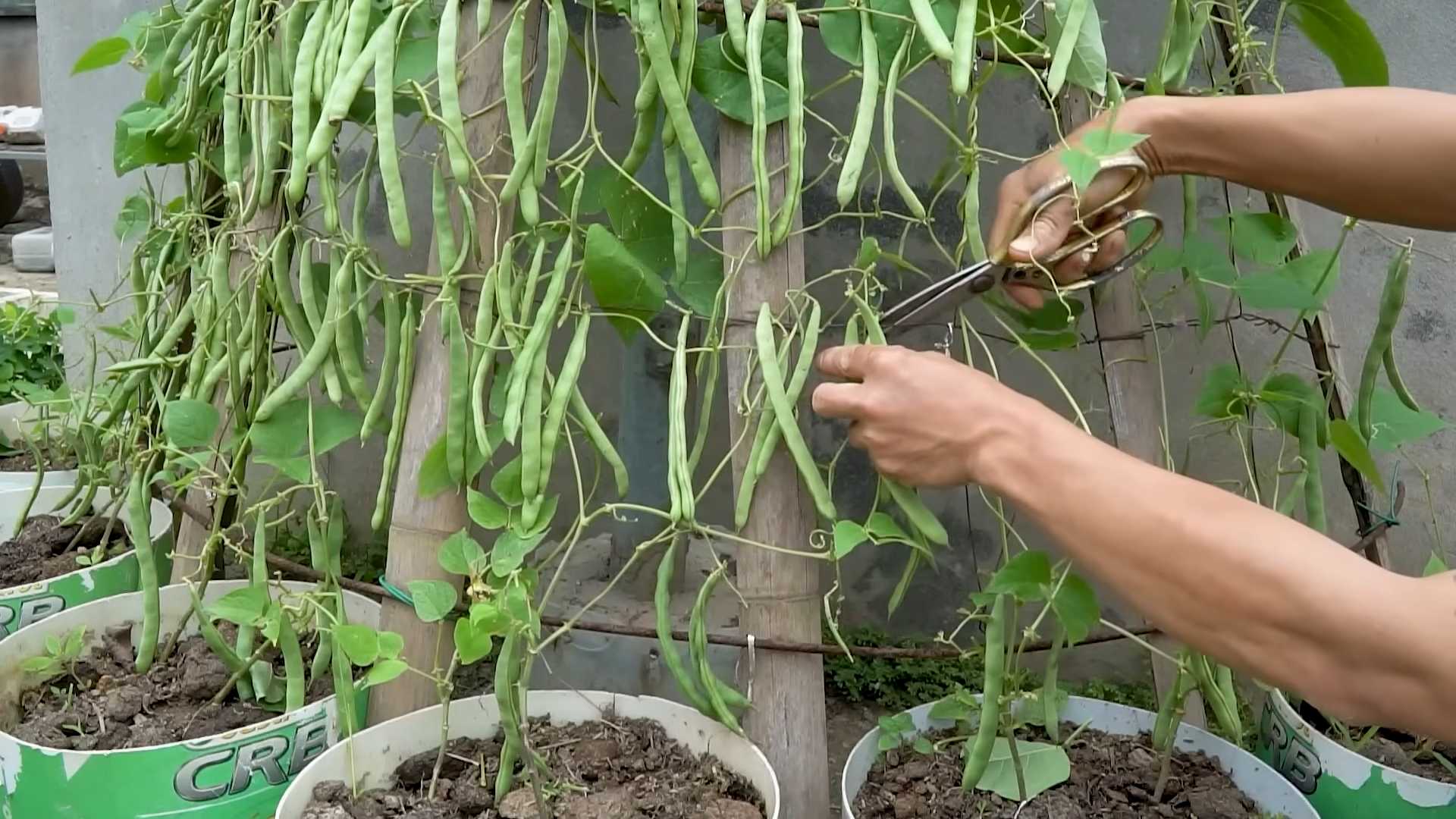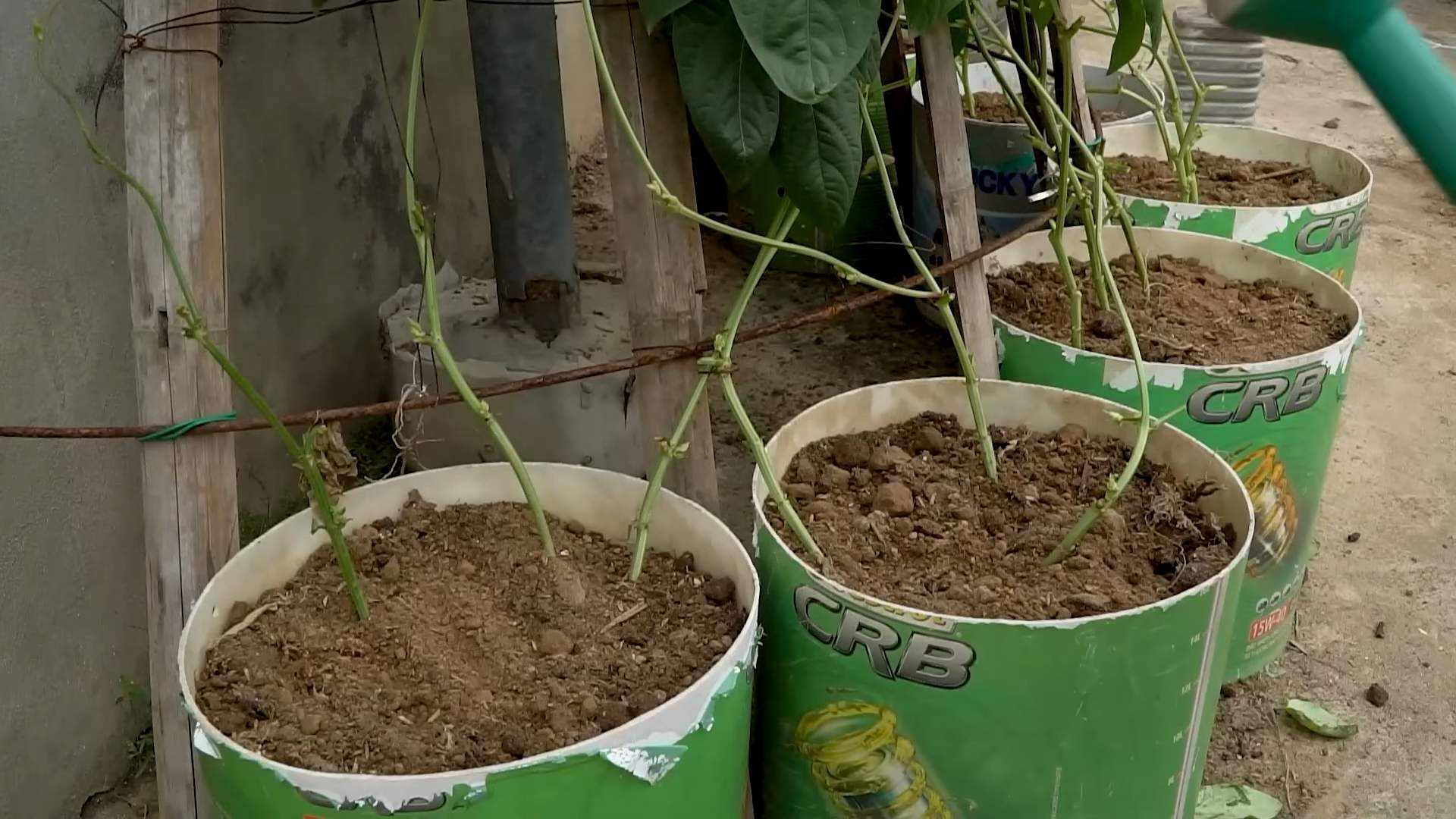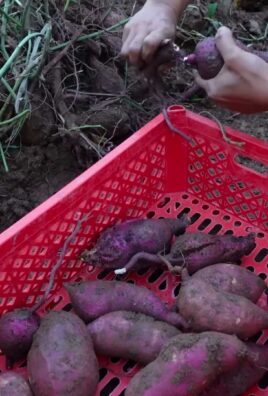Lazy way to grow long beans? Yes, you read that right! Forget back-breaking labor and endless weeding. I’m about to share some seriously clever DIY tricks that will have you harvesting armfuls of delicious long beans with minimal effort. For centuries, cultivating beans has been a cornerstone of diets worldwide, from ancient civilizations in the Americas to bustling Asian markets. These versatile legumes are packed with nutrients and, thankfully, relatively easy to grow.
But let’s be honest, sometimes life gets in the way, and our gardening aspirations take a backseat. That’s where these DIY hacks come in. Imagine enjoying fresh, homegrown long beans in your stir-fries, salads, and soups without spending hours toiling in the garden. These tips are perfect for busy individuals, beginner gardeners, or anyone who simply prefers a more relaxed approach to growing their own food.
Why do you need these DIY tricks? Because everyone deserves access to fresh, healthy produce, regardless of their gardening experience or time constraints. I’m going to show you how to sidestep common gardening pitfalls and maximize your yield with minimal fuss. Get ready to discover the lazy way to grow long beans and transform your garden into a bountiful, low-maintenance paradise!

The Lazy Gardener’s Guide to Bountiful Long Beans
Okay, let’s be honest, sometimes we want a garden overflowing with delicious veggies, but the thought of all the work involved? Not so appealing. That’s where this super-easy, almost-effortless method for growing long beans comes in. I call it the “Lazy Gardener’s Long Bean Bonanza,” and trust me, it works! We’re talking minimal weeding, less watering, and a whole lot of long beans.
What Makes This Method “Lazy”?
This method focuses on creating a self-sustaining, low-maintenance environment for your long beans. We’re using companion planting, mulching, and a simple trellis system to minimize the work you have to do while maximizing your harvest. Think of it as setting up a little long bean ecosystem that mostly takes care of itself.
Materials You’ll Need
Before we dive in, let’s gather our supplies. Don’t worry, most of this stuff is pretty common and inexpensive.
* Long bean seeds (obviously!) – I recommend a variety that suits your climate.
* A sunny spot in your garden (at least 6 hours of direct sunlight).
* Compost or well-rotted manure.
* Straw or other organic mulch (shredded leaves, wood chips, etc.).
* A few companion plants:
* Marigolds (to deter pests).
* Basil (to attract pollinators and repel pests).
* Radishes (to break up the soil and deter some pests).
* Trellis materials:
* Bamboo poles, sturdy branches, or metal stakes.
* Twine, rope, or zip ties.
* Gardening gloves.
* A shovel or trowel.
* Watering can or hose.
Step-by-Step Planting Guide
Alright, let’s get our hands dirty! Here’s how to set up your lazy long bean garden:
1. Prepare the Soil: First, choose your sunny spot. Long beans need plenty of sunshine to thrive. Then, dig over the soil, loosening it up to a depth of about 12 inches. This will make it easier for the roots to grow. Mix in a generous amount of compost or well-rotted manure. This will provide your long beans with the nutrients they need to get started. I usually aim for a 2-3 inch layer of compost mixed into the soil.
2. Plant Your Companion Plants: Before planting the long beans, let’s get our companion plants in the ground. Plant marigolds around the perimeter of your planting area to deter pests. I like to space them about 12 inches apart. Next, tuck in some basil plants amongst where you plan to plant the long beans. Basil not only attracts pollinators but also helps repel some common long bean pests. Radishes can be sown directly into the soil between the spots where you’ll plant your long beans. They’ll help break up the soil and deter some pests.
3. Sow the Long Bean Seeds: Now for the star of the show! Sow your long bean seeds directly into the ground, about 1 inch deep and 4-6 inches apart. I usually plant two seeds per hole, just in case one doesn’t germinate. Once the seedlings emerge, you can thin them out, leaving the strongest one. Water the seeds gently after planting.
4. Build Your Trellis: Long beans are climbers, so they need a trellis to support their growth. There are many ways to build a trellis, but here’s a simple and effective method:
* Drive bamboo poles, sturdy branches, or metal stakes into the ground at regular intervals along your planting row. I usually space them about 3-4 feet apart.
* Tie twine or rope between the poles, creating a grid-like structure for the long beans to climb. You can also use zip ties to secure the twine to the poles.
* Make sure the trellis is sturdy enough to support the weight of the mature long bean plants.
5. Mulch, Mulch, Mulch!: This is where the “lazy” part really kicks in. Apply a thick layer of straw or other organic mulch around the base of the plants. This will help retain moisture, suppress weeds, and regulate soil temperature. I usually aim for a 3-4 inch layer of mulch.
6. Watering: Water your long bean plants regularly, especially during dry periods. Water deeply, soaking the soil around the roots. Avoid watering the foliage, as this can encourage fungal diseases. Mulching will help reduce the frequency of watering needed.
7. Training the Vines: As the long bean vines grow, you may need to gently guide them onto the trellis. Simply weave the vines through the twine or rope. They’ll eventually start to climb on their own.
8. Fertilizing (Optional): If your soil is particularly poor, you may need to fertilize your long bean plants. Use a balanced organic fertilizer, following the instructions on the package. I usually only fertilize once or twice during the growing season.
9. Pest Control (Minimal): Thanks to our companion plants and healthy soil, pest problems should be minimal. However, keep an eye out for common long bean pests like aphids and bean beetles. If you spot any pests, you can try hand-picking them off the plants or spraying them with insecticidal soap.
10. Harvesting: The best part! Long beans are ready to harvest when they are about 12-18 inches long and still tender. Pick them regularly to encourage more production. Use scissors or pruning shears to cut the beans from the vine.
Troubleshooting
Even with the laziest methods, sometimes things don’t go exactly as planned. Here are a few common problems you might encounter and how to deal with them:
* Poor Germination: If your long bean seeds aren’t germinating, make sure the soil is warm enough (at least 60°F). You can also try soaking the seeds in water for 24 hours before planting.
* Yellowing Leaves: Yellowing leaves can be a sign of nutrient deficiency. Try fertilizing your plants with a balanced organic fertilizer.
* Pest Infestations: If you’re dealing with a pest infestation, try hand-picking the pests off the plants or spraying them with insecticidal soap. You can also introduce beneficial insects like ladybugs to your garden.
* Lack of Flowers or Beans: If your long bean plants are growing well but not producing flowers or beans, it could be due to a lack of pollination. Make sure you have plenty of pollinators in your garden by planting flowers that attract bees and butterflies.
Tips for an Even Lazier Garden
Want to make this method even lazier? Here are a few extra tips:
* Use a Drip Irrigation System: A drip irrigation system will deliver water directly to the roots of your plants, reducing water waste and minimizing the need for hand-watering.
* Plant a Cover Crop in the Off-Season: Planting a cover crop like clover or rye in the off-season will help improve soil health and suppress weeds.
* Compost Your Garden Waste: Composting your garden waste will provide you with a free source of nutrient-rich compost for your long bean plants.
* Embrace the Weeds (Sort Of): Not all weeds are bad! Some weeds can actually be beneficial to your garden. For example, dandelions can help break up the soil and provide nutrients. Just be sure to remove any weeds that are competing with your long bean plants for resources.
Enjoy Your Bountiful Harvest!
And that’s it! With a little bit of initial effort, you can have a thriving long bean garden with minimal work. So sit back, relax, and enjoy the fruits (or rather, beans) of your labor. Happy gardening!

Conclusion
So, there you have it! This lazy, yet incredibly effective, method for growing long beans is a game-changer for any gardener, regardless of experience level. Forget the back-breaking labor and complicated setups. This DIY trick simplifies the entire process, allowing you to enjoy a bountiful harvest of delicious, fresh long beans with minimal effort.
Why is this a must-try? Because it’s efficient, cost-effective, and incredibly rewarding. Imagine the satisfaction of harvesting your own long beans, knowing you achieved it with a fraction of the work typically required. This method maximizes space, reduces weeding, and provides excellent support for the vigorous growth of long bean vines. Plus, it’s a fantastic way to recycle materials you might already have around the house, making it an environmentally friendly choice.
But don’t just take our word for it! We encourage you to experiment and adapt this method to suit your specific needs and preferences. For example, if you live in a particularly windy area, consider using sturdier stakes or adding extra support to your structure. You could also try different types of containers, from repurposed buckets to large grow bags.
Variations to consider:
* Vertical Trellis System: Instead of individual stakes, create a larger vertical trellis using netting or wire mesh. This is ideal for growing multiple long bean plants in a smaller area.
* Companion Planting: Plant beneficial herbs like basil or marigolds around your long beans to deter pests and attract pollinators.
* Succession Planting: Plant new long bean seeds every few weeks to ensure a continuous harvest throughout the growing season.
* Container Size: Experiment with different container sizes to see what works best for your long bean variety. Larger containers generally hold more moisture and nutrients, leading to healthier plants.
* Soil Amendments: Incorporate compost or other organic matter into your soil to improve drainage and fertility.
The possibilities are endless! The key is to find what works best for your garden and your long bean plants.
We are confident that this lazy way to grow long beans will transform your gardening experience. It’s a simple, effective, and enjoyable way to cultivate these delicious vegetables. So, grab your seeds, gather your materials, and get ready to enjoy a bountiful harvest.
Don’t forget to share your experiences with us! We’d love to hear about your successes, challenges, and any variations you’ve tried. Share your photos and stories on social media using #LazyLongBeans and let’s inspire others to embrace this easy and rewarding gardening method. Happy gardening!
Frequently Asked Questions (FAQ)
What exactly are long beans, and why should I grow them?
Long beans, also known as yardlong beans, asparagus beans, or Chinese long beans, are a type of legume characterized by their exceptionally long pods, which can grow up to three feet in length. They are a popular vegetable in Asian cuisine and are known for their crisp texture and slightly sweet flavor.
Growing long beans offers several advantages. They are relatively easy to grow, especially with this lazy method, and they produce a high yield. They are also a good source of vitamins, minerals, and fiber. Plus, nothing beats the taste of freshly harvested, homegrown vegetables!
What kind of soil is best for growing long beans?
Long beans prefer well-draining soil that is rich in organic matter. A slightly acidic to neutral pH (around 6.0 to 7.0) is ideal. Before planting, amend your soil with compost, aged manure, or other organic materials to improve drainage, fertility, and water retention. If your soil is heavy clay, consider adding sand or perlite to improve drainage.
How much sunlight do long beans need?
Long beans require at least 6-8 hours of direct sunlight per day to thrive. Choose a sunny location in your garden for planting. If you live in a particularly hot climate, some afternoon shade may be beneficial to prevent the plants from overheating.
How often should I water my long bean plants?
Water your long bean plants regularly, especially during hot, dry weather. Aim to keep the soil consistently moist but not waterlogged. Water deeply at the base of the plants, avoiding wetting the foliage, which can increase the risk of fungal diseases. Mulching around the plants can help retain moisture in the soil.
What kind of support do long beans need?
Long beans are climbing plants and require support to grow properly. This lazy method utilizes stakes, but you can also use trellises, fences, or other structures. The support should be sturdy enough to hold the weight of the mature vines and pods. Ensure the support is tall enough to accommodate the full length of the vines.
How long does it take for long beans to mature?
Long beans typically take 60-80 days to mature after planting. You can start harvesting the pods when they are about 12-18 inches long and still tender. Regular harvesting encourages the plant to produce more pods.
What are some common pests and diseases that affect long beans?
Common pests that can affect long beans include aphids, bean beetles, and spider mites. Diseases include fungal diseases like powdery mildew and rust. Regularly inspect your plants for signs of pests or diseases and take appropriate action. Organic pest control methods, such as insecticidal soap or neem oil, can be effective. Ensure good air circulation around the plants to prevent fungal diseases.
Can I grow long beans in containers?
Yes, long beans can be successfully grown in containers, especially using this lazy method. Choose a container that is at least 12 inches deep and wide to provide enough space for the roots to grow. Use a well-draining potting mix and provide adequate support for the vines.
How do I harvest long beans?
Harvest long beans when the pods are about 12-18 inches long and still tender. Use scissors or pruning shears to cut the pods from the vine, leaving a short stem attached. Harvest regularly to encourage the plant to produce more pods.
Can I save seeds from my long bean plants?
Yes, you can save seeds from your long bean plants. Allow some of the pods to mature fully on the vine until they are dry and brown. Remove the seeds from the pods and store them in a cool, dry place for planting next season. However, be aware that if you are growing multiple varieties of beans, cross-pollination may occur, resulting in seeds that produce plants with different characteristics.
What are some ways to use long beans in cooking?
Long beans are a versatile vegetable that can be used in a variety of dishes. They can be stir-fried, steamed, boiled, or grilled. They are often used in Asian cuisine, such as stir-fries, curries, and soups. They can also be added to salads or served as a side dish.
Is this “lazy way to grow long beans” suitable for beginners?
Absolutely! That’s the beauty of it. This method is designed to be simple and straightforward, making it perfect for beginner gardeners. The reduced labor and easy setup make it a less daunting task compared to traditional gardening methods. Even if you’ve never grown anything before, you can successfully grow long beans using this technique.




Leave a Comment